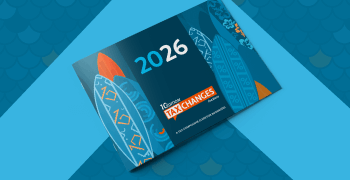Sales tax sourcing: How to find the right rule for every transaction
Getting sales tax right should be a goal for every business that deals with sales tax. To do so, you need to know which rates and rules apply to each transaction. Unfortunately, that’s not always immediately apparent because rates and rules depend on how a sale is sourced, and sourcing rules vary from state to state.
The most straightforward scenario is when a sale begins and ends in the same jurisdiction. For example, when a consumer enters a store in Clever, Missouri, buys shampoo, and carries it out the door — the sale is sourced to Clever and the rates and rules in effect in Clever apply.
However, most scenarios are not this straightforward. Determining the source of a sale is a bit trickier when the buyer and seller are in different jurisdictions. And that situation is happening more than ever thanks to ecommerce; the internet makes it so simple for retailers and consumers located in different parts of the country or globe to connect.
In general, there are three ways to determine sourcing rules:
- Destination sourcing: Rates and rules are based on the location of the buyer
- Origin sourcing: Rates and rules are based on the location of the seller
- Mixed sourcing: A mix of destination and origin sourcing
Whether origin sourcing or destination sourcing applies may depend on the rules in effect in the state, the location of the sale, and the type of sale — interstate or intrastate.
Destination sourcing
Most states use destination sourcing for interstate sales, when the seller is located in one state and the buyer is in another.
Most states also use destination sourcing for intrastate sales, when the buyer and seller are in different jurisdictions within the same state.
However, there are exceptions for every rule, as you’ll see below.
Origin sourcing
Rates, rules, and regulations in the following states are generally based on the origin of the sale — the location of the sale:
- Arizona
- Illinois
- Missouri
- New Mexico
- Tennessee
- Utah
- Virginia
Mixed sourcing
Sourcing rules in the following states are mixed, meaning tax rates and rules depend on the product or service being sold, or unique jurisdiction rules.
California. The statewide sales tax is based on the origin of the sale. However, district taxes (levied within cities or countywide) are generally based on the destination of the sale (the delivery address). Sales of certain services are based entirely on the destination.
Starting April 1, 2019, California is enforcing economic nexus: Out-of-state sellers will be required to collect and remit California state sales tax if they have more than $100,000 in sales for delivery into California or at least 200 separate transactions for delivery into the state in the preceding or current calendar year.
Additionally, both in-state businesses and out-of-state businesses will have to collect applicable district taxes when their sales into a district exceed the $100,000 sales/200 transactions threshold during the current or preceding calendar year. Learn more about sales tax sourcing and nexus changes in California.
Ohio. Sourcing rules vary based on the type of the transaction. For example:
Retail sales of tangible personal property (TPP) by an Ohio vendor to an Ohio consumer are sourced to the location where the order was received, regardless of the ship-from address.
Retail sales of TPP not made from a fixed location (e.g., vending machine sales, temporary sales) are sourced to the location where the sale occurs.
Retail sales of taxable services by an Ohio service provider to an Ohio consumer are sourced to the location where the consumer receives the service.
Retail sales of TPP or taxable services from outside Ohio to an Ohio consumer are sourced to the location where the consumer receives the TPP or service.
Pennsylvania. Sales of products (tangible personal property) are generally based on the origin of the sale, while sales of services follow destination sourcing rules.
Texas. Sourcing rules vary (see Local Sales and Use Tax Collection – A Guide for Sellers) as follows:
- An order placed in person at a seller’s place of business in Texas is sourced to that location (origin sourcing).
- An order fulfilled at a seller’s place of business in Texas is sourced to that location if the order was taken in another location.
- An order received at a seller’s place of business but not fulfilled in Texas is sourced to the location where the order was received.
- An order not received or fulfilled at the seller’s place of business in Texas, but fulfilled at a Texas location, is sourced to the location in Texas from which the order is shipped or delivered (origin sourcing).
Currently, Texas sales tax doesn’t apply to an order received, fulfilled, and delivered from a location outside of Texas. However, local use tax may be due if the order is delivered to a location in Texas that’s within the boundaries of a local jurisdiction. And new collection and reporting requirements are scheduled to take effect in Texas on October 1, 2019.
Colorado
Colorado deserves a special callout because of its changing nexus and sourcing rules. The changes took effect on December 1, 2018, but the state has granted a grace period through May 31, 2019, to facilitate the transition for businesses.
As with California, out-of-state sellers must register with the tax department and collect and remit tax on Colorado sales if they have economic nexus in the state — more than $100,000 in annual gross sales of products or services in the state, or 200 or more separate transactions delivered into the state in the current or previous calendar year.
Once registered, retailers must collect the state sales tax and all state-collected local and special district sales taxes in effect at the destination of the sale.
But Colorado allows home rule, and it doesn’t collect or administer sales tax for more than 70 self-collecting jurisdictions in the state. This doesn’t mean retailers that make sales in those jurisdictions have no local tax obligation; it means they need to contact the jurisdiction to determine what, if any, local taxes apply to their sales. Here’s a list of state-collected and non-state collected districts.
The changes currently underway in Colorado are complicated and affect both in-state and out-of-state retailers. Learn more about them in the Colorado Department of Revenue’s Information for in-state retailers and Information for out-of-state retailers.
Determining how each sale is sourced is an integral part of sales tax compliance, but it’s just one step of many. All of it, from registration to sourcing to calculation and remittance is easier when you automate sales tax compliance.

Avalara Tax Changes 2026 is here
The 10th edition of our annual report engagingly breaks down key policies related to sales tax, tariffs, and VAT.
Stay up to date
Sign up for our free newsletter and stay up to date with the latest tax news.














